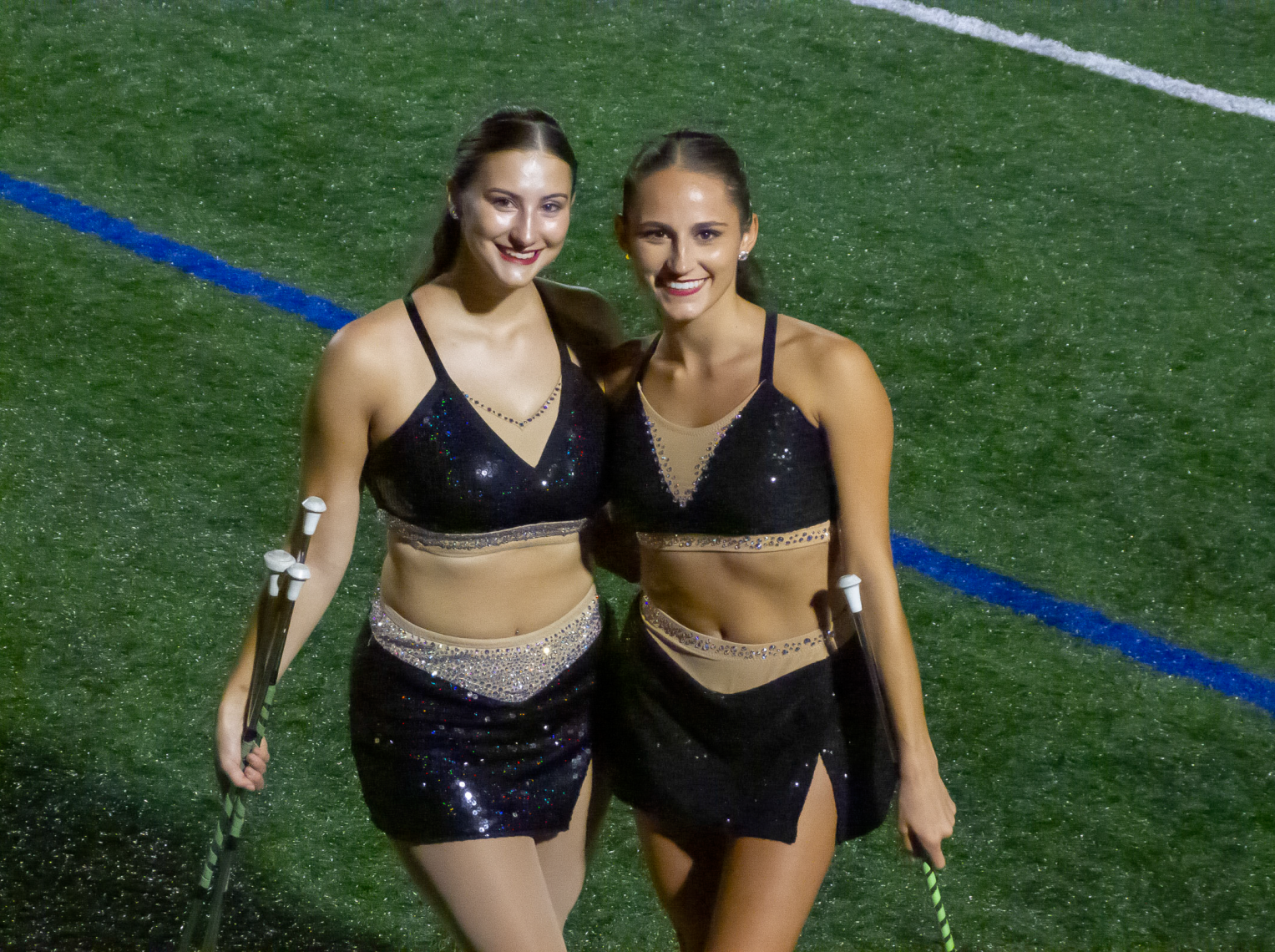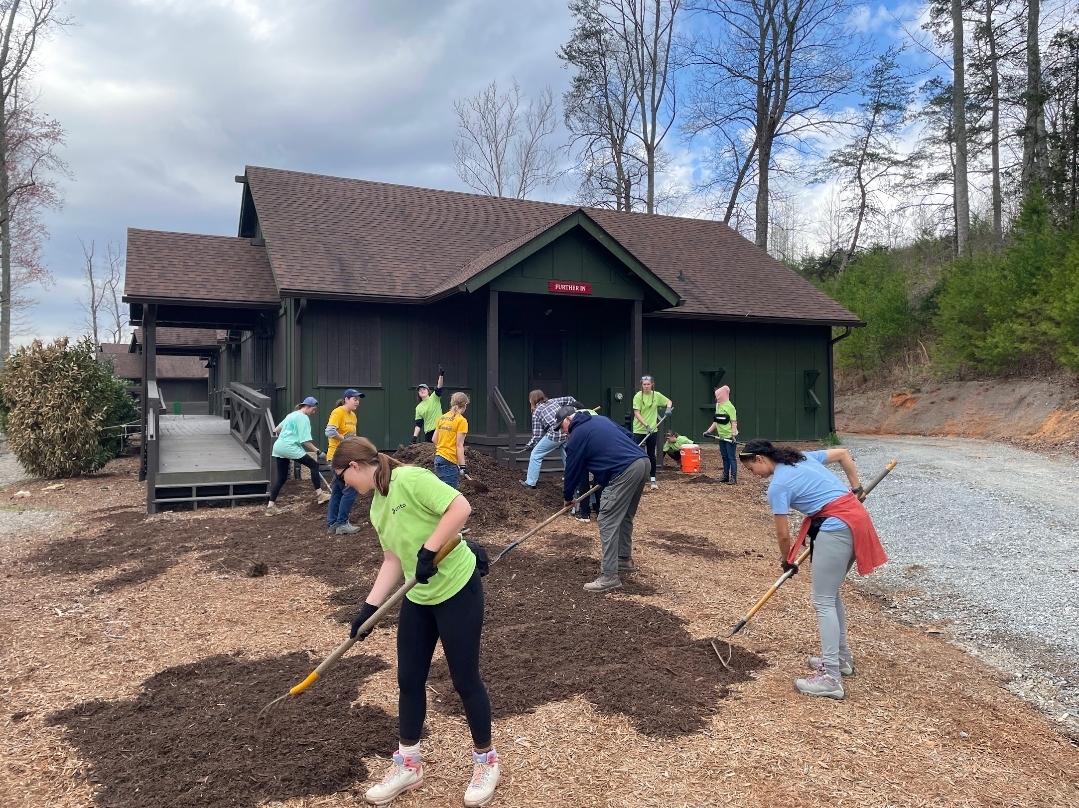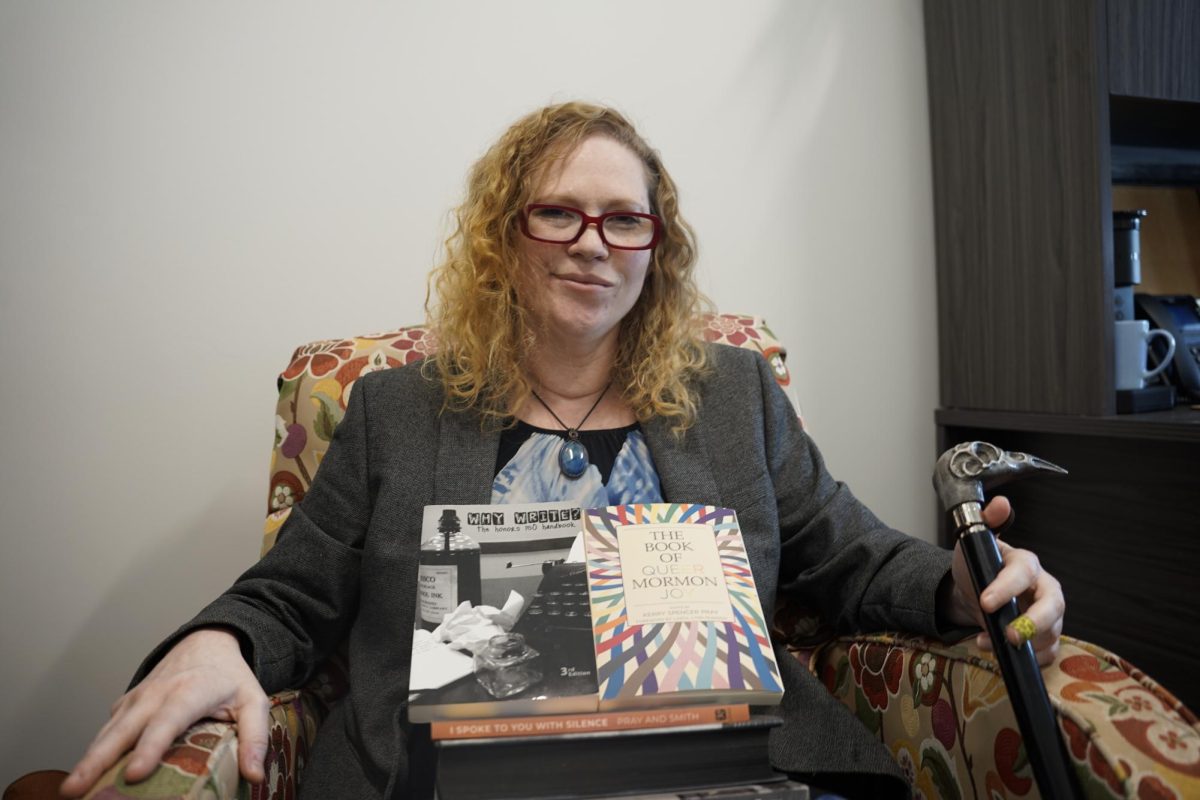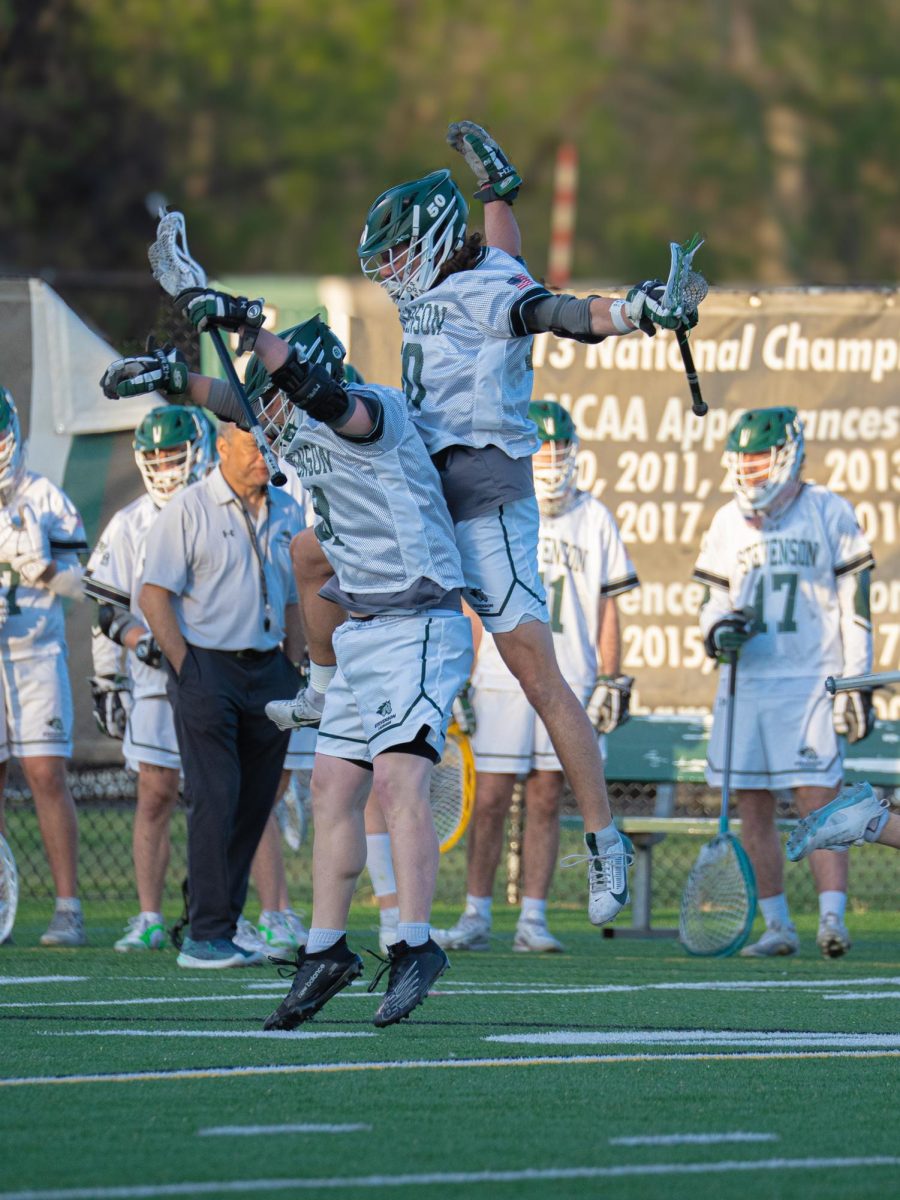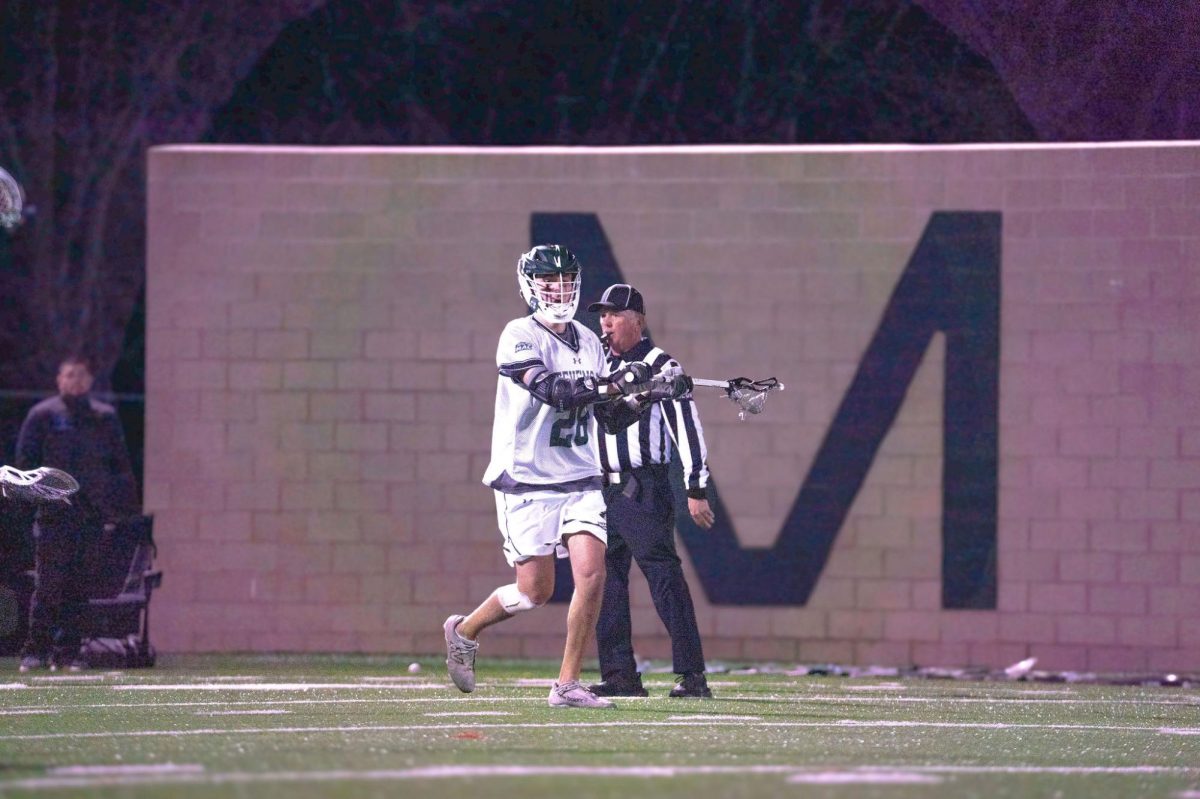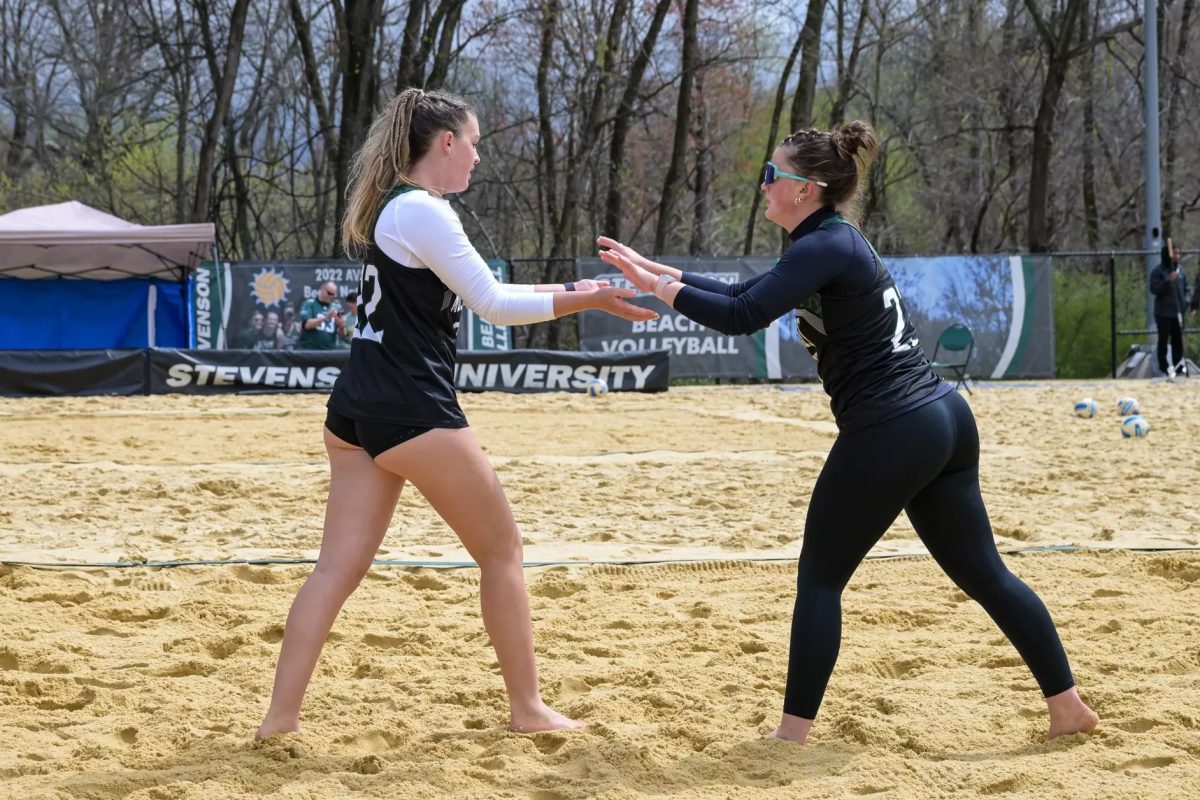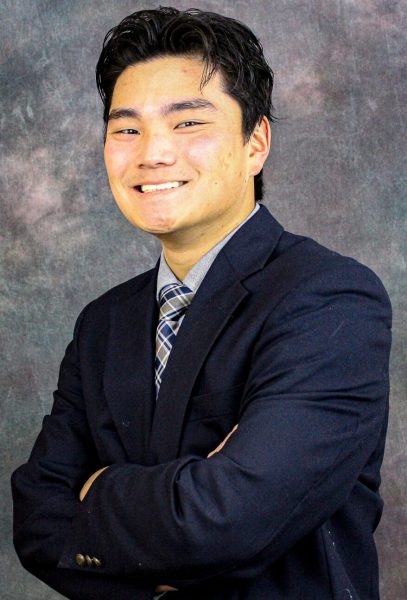Less than five years ago, feature twirling was unheard of at Stevenson University. Now, it is a front-and-center sport during halftime shows for various Stevenson sporting events as second-year Gianna Romero and third-year Katelyn Sypolt collaborate tossing batons and putting their choreography in full display in front of packed Mustang crowds.
While twirling still may be fairly new to Stevenson, the two of them have been at it for a long time. Their history in twirling derives from early involvement in dance and/or gymnastics.
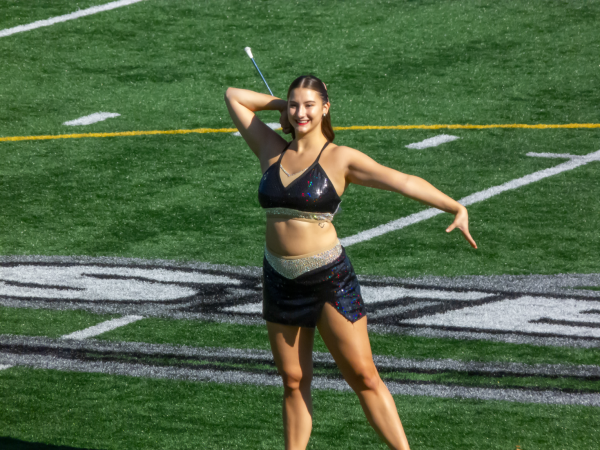
Sypolt, one of the original feature twirlers at Stevenson, has been involved in dance since she was nine years old, though she was active in almost every sport imaginable including gymnastics, lacrosse and soccer. A native of Calvert County, Maryland, she aspired to be a dancer growing up though because many dance companies near here had high price demands, her parents signed her up for recreational dancing instead. Growing up, she enjoyed a 10-year stint at Trilogy Twirl Club as well as time with the Dynamic Dance Twirl Team, and it was during this time period where she learned to twirl, too.
In 2015, she competed in a regional championship in Pennsylvania, completely fell in love with twirling, and was ready to take it to another level.
“You see the difference between local rec [organizations] and people who are doing this to get scholarships in college, to take it to the next level,” Sypolt said. “It’s a whole different type of world. It’s a whole different type of communication between [twirlers] and it’s more fun.”
While she no longer competes, Sypolt stays involved with not just Stevenson, but still with Trilogy. She recently obtained her coach’s certification in twirling and is there full-time passing her knowledge down to a new generation of twirlers.
Sypolt says that while she misses the competing lifestyle that she knew for so long, she is still happy to be in the gym in a different role working with younger twirlers that she considers “passionate and ready to be taught something.”
“One of my favorite things about coaching is seeing them progress and knowing that they are getting somewhere in the sport,” Sypolt said. She also mentioned that her training experience growing up heavily influences her coaching style. “I feel like having a coach that wants you to continuously push yourself to be the best has been one of the main reasons why I [twirled] for so long. Coaches have a big part in how you think baton is going to be for you. Being with the younger kids helps me realize that as a coach, you can either help that situation [for a student] or break it. I love them so much, and I only want them to be their best.”
Romero, a native of Bel Air, Maryland, began gymnastics when she was two years old. After eight years in the sport, she decided to take a different path that would incorporate both dance and gymnastics. Around the age of nine, she got involved in rec twirling and soon gained interest in competitive baton twirling. At Wheaton Dance & Twirl, she went on a rigorous schedule of 9 a.m. to 5 p.m. practices on the weekends during the school year, and the same time frame Monday through Friday in the summer time.
Romero, who is also an official state preliminary as Miss Bel Air, remembers the first time she saw baton twirling as a kid, and she was taken away by the sport.
“As a kid, twirling looks crazy because you are tossing a baton up and catching it, and it’s sparkling in the sky, but that was intriguing to me,” Romero said.
Outside of twirling, Romero carries a tremendous passion for dancing. She is classically trained and was involved with both the John Carroll School College Preparatory Dance Program and many Hartford Dance Theatre productions prior to Stevenson.

“Twirling is dancing with a baton,” Romero said. “You are always doing something with your body. You are never just standing in relaxed form. Dance really prepared me for that.”
Along with dance, gymnastics and twirling are also closely correlated, which is primary reason why she indulged in twirling. She could do all three at the same time in an artistic form.
“Gymnastics is also included, so you can do certain body work elements like walkovers, cartwheels, back-hand springs, and even flips. They’re all basically the same thing, and they feed off of each other well,” Romero said.
Both Romero and Sypolt have a plethora of achievements from twirling prior to Stevenson including individual, state, regional and national titles. Romero, in particular, has a colorful resume as she was a member of world and national championship teams at Wheaton. She is also the 2022 Kozkoska Memorial High School champion in twirling. All of this experience split between Romero and Sypolt has now made its way to Stevenson.
Sypolt arrived at Stevenson in the fall of 2022. With a degree in criminal justice under way, she originally committed to the acro-tumbling team. After a quick change of heart, she joined forces with then third-year Makala Farace, her former teammate at Dynamic, to begin feature twirling at the school.
Sypolt wanted it to happen badly.
“I wanted to do it enough that I did not top pushing the fact to the athletic department,” Sypolt recalled. “When we had our meeting with [athletic director] Brett Adams, he seemed interested. He was super happy that we did not stop [asking].”
They finally got the approval from Adams, and they got the ball rolling with halftime performances beginning that same fall at Stevenson football games. The moment that Sypolt and Farace took the field made history at Stevenson as they had officially introduced feature twirling to Stevenson. A year later in 2023, they added Romero. With Farace departing after the 2023-2024 school year via graduation, Romero and Sypolt now stand as their own duo representing Stevenson University feature twirling.
Feature twirling at Stevenson is self-coached, so Romero and Sypolt have complete control of everything. First, they choose what song(s) they want to use for their routines. Then, they organize routines and get to work. It typically takes them a couple of days to sketch a routine. They practice two days a week and average around two hours per practice. On game day, they spend the first half of the game getting loose and preparing to take the field. When halftime arrives, it’s show time.
Choosing a song is more important than one may think.
“The first thing is finding a song that will entertain both [us] and the crowd,” she said. “A boring song is not going to be a great performance aspect. Especially nowadays, it’s really hard to find music that is super upbeat, happy, and entertaining.”
It is also worth noting that Stevenson University feature twirling is completely different from a traditional Division I twirling experience. Traditionally, twirlers are a part of a marching band’s halftime choreography. They perform the halftime shows and parades, and they may even see some action during some basketball games in the winter. After that, however, the season ends for twirlers. At Stevenson, feature twirling is separate from the rest of the halftime entertainment, and they are their own entity. They are in complete control of everything that they do and they are acknolwedged separately from the rest of the entertainment. In addition, Stevenson’s feature twirlers will now get to perform year-round. Aside from football and basketball games, the feature twirlers will now be performing at lacrosse games.
According to both Romero and Sypolt, being their own individual act has had major benefits for Stevenson feature twirling.
“I think it has been a really great experience because then we get to dictate what we want to do, where we want to move, what kind of music we will enjoy twirling to,” Romero said. “It makes [twirling] more customizable to what you want and it really allows you to feed off the crowd and for them to see what twirlers are. We’re not just a part of the band. We are an entire entity to ourselves.”
Because they are their own act, Romero and Sypolt have received immense support from the Stevenson community. They are very thankful for support from Lisa Labrecque, Assistant to the Athletic Director and Casey Nelson, Athletic Equipment Manager. Both have supported them emotionally, but also with the equipment and availability necessary to make twirling at Stevenson possible.
The two are especially thankful for the support of their friends, family, classmates and the Mustang fans. They have even received support from fans of the visiting team.
“Mustang Stadium has a lot more energy than you think it will,” Romero said. “Even now that people know us more, I feel very lucky that we can even hear people calling out our names and screaming for us before we go on [the field].”
Them being their own act also means that the two spend a lot of time together. Neither Romero or Sypolt really knew each other closely prior to Stevenson. They knew of each other throughout their years in rec twirling and competition. However, Stevenson has brought them closer than ever before. Stevenson feature twirling has made a friendship for them that will last a lifetime.
Sypolt describes their friendship that of siblings.
“We butt heads a lot of the time, but we always come back,” Sypolt said. “Obviously, you’re going to have ups and downs in any relationship. At the end of the day, we know that we are here for each other and that we are a call away. [This is] definitely a lifelong friendship. We have gotten close in the short amount of time that we’ve known each other mostly because we have [twirling] but we bond over a lot of other things too.”
Romero feels that her friendship with Sypolt has helped her navigate Stevenson, especially since she is still in her early years of college. She appreciates that the connection has helped each of them get through some good times and some bad times.
“It gives you someone at Stevenson that you know so it makes the campus feel a lot less scary and a lot less big,” Romero said. “You know someone that you can call and talk to if something’s going wrong.”
The pair’s connection also contributes to their enjoyment of twirling.
“I always like to say that ‘we work hard, but we do play hard.’ So sometimes, our practices turn into just sitting down and talking for a bit. We are similar with a lot of things that we do, but we are also different. We can get different opinions, feed off of each other, and support each others in ways that maybe we cannot support ourselves,” Romero said.
By next year, Sypolt will graduate early, and Romero will either stand alone on the field or alongside new twirlers. Both girls admit that twirling is not the most widely-recognized sport around, though its popularity is beginning to pick up. This is the perfect time for them to spread the word and with the time that they have left together; they want to bring as much attention to the sport as possible.
“I feel like most twirlers: our goal is to bring recognition to the sport because it is so small,” Romero said. “We want to show that twirling is a hard core sport that takes a lot of dedication, but it is also beautiful and graceful at the same time. Twirling really is everything all combined.”
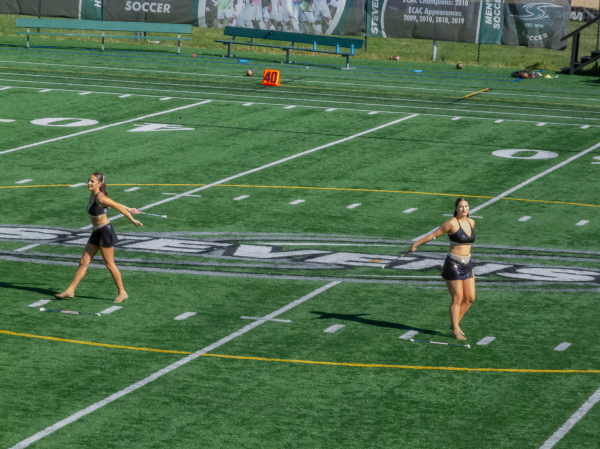
Perhaps more importantly, they want to promote twirling at a DIII school. Many DIII schools do not have feature twirling, or twirling in general, like Stevenson does. In addition, according to Romero, there is a running stigma that in order to twirl in college, the only way to go is to twirl at a big name DI school. However, according to both Romero and Sypolt, Stevenson proves exactly why that is not the case. Especially for twirlers who do not want to travel far away from home, sit in lecture halls full of a hundred students or get lost in an overwhelmingly large community, a smaller family-first university like Stevenson provides every bit of intimacy and connection possible.
This is all why Sypolt loves twirling at Stevenson.
“Maryland is one of the bigger states that has a lot of baton twirlers and people interested in baton twirling in college that don’t necessarily want to go to Big 10 schools,” Sypolt said. “[Stevenson] is definitely a better option if you are like me and want to go to a smaller school that is a little bit closer to home and a little more family-oriented than ‘party out everyday.”
Events like “Be A Twirler For A Day” help promote exactly what Romero and Sypolt want, and that is twirling at a DIII school like Stevenson. At this year’s event, they welcomed 16 guests from in and out of the state of Maryland, double the number they had the year prior. In addition, they have a strong social media following on Instagram where they post highlights from performances, twirling tricks and skills on “Trick Tuesday,” and other content to help followers get to know them on and off the field. While they are pleased with the rise in popularity in the sport in Baltimore County, the two know that their job is far from finished.
With Sypolt’s pending departure and with the possiblity of Romero twirling solo next year, both of them are heavily focused on recruiting. The overall goal, however, is to attract more twirlers to Stevenson so that the message is clear: DIII schools provide a great twirling experience just like a big-name school would.
Sypolt wants to see twirling grow to new heights as she transitions out of Stevenson.
“It was a low-profile sport, and not a lot of people knew about it,” Sypolt said. “But now, I feel like it is getting more well-known. I hope it gets a lot more recognition, especially at Stevenson.”
Romero and company will soon be carrying on the legacy that Farace and Sypolt started. She wants to “change the narrative of twirling at a DIII school.” Needless to say, both her and Sypolt are twirling with an intent while re-writing the script.
“Like Katelyn said, twirling is really picking up in popularity especially with children going to games, seeing twirlers on the field, and thinking that is really a cool sport to do,” Romero said. “[We want it to] become a Stevenson thing. We want Stevenson to be known for being a great school and having great athletic programs, but also having really amazing twirlers on the field.”



